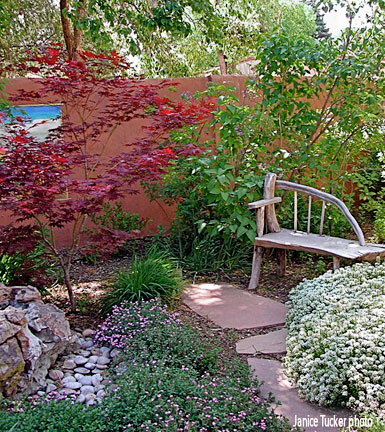Scientific Name: Acer palmatum ‘Atropurpureum’
Plant Family: Acer – Maple
Common Name: Redleaf Japanese maple
By Janice Tucker
While not entirely rare or uncommon, the appearance of a Redleaf Japanese maple in a Santa Fe Garden is always a bit of a pleasant surprise and a delight to see. Whether tucked into a small, private nook or used more extensively, these small trees add an artistic touch to any garden. Among the 12 lovely gardens showcased during the Santa Fe Botanical Garden’s 2011 tour of private gardens, one garden on the second tour day will demonstrate the beauty of incorporating the Japanese maple throughout the landscape design.

Redleaf Japanese Maple (photo: Janice Tucker)
Desired mostly for its red leaf color from spring until fall, the most popular cultivars of Japanese maple available commercially in the Santa Fe area are the Redleaf Japanese maple (Acer palmatum ‘Atropurpureum’) and to a lesser extent, the smaller, usually more expensive cultivar Bloodgood Japanese maple (Acer palmatum var. atropurpureum ‘Bloodgood’).
The Redleaf maple grows to a height between 20 to 25 feet, with a canopy of up to 25 feet. The Bloodgood maple can reach a maximum height of 20 feet with a canopy spreading to 15 feet. The Bloodgood is also a popular bonsai plant. Besides the difference in the mature height of the two trees, the Redleaf grows more rapidly and has a greater variation in leaf color, beginning in spring with a light burgundy and gradually changing to a more orange or bronze color by late summer. The Bloodgood’s leaves tend to keep a uniform purple-red color from spring until fall.
These small, deciduous trees are native to Japan and thrive in acid moist soil. Their growth habit is somewhat hemispheric. Although many sources recommend planting the Japanese maple in full to partial sun, a shadier spot may be preferred for the Santa Fe area because of the intense New Mexico sunlight. It is best to check with local nurseries or landscape designers regarding light and water requirements. Allow the tree at least a year to become well established as the first year’s growth may appear smaller than anticipated. During that time, the tree is putting energy into establishing its root system.
The wide, red-purple, pointed, palmated leaves of the Redleaf Japanese maple have from five to seven lobes. The small, white flowers consist of five petals positioned above five reddish-purple sepals. The fruit (or seed) is known as samara and is formed in winged pairs. These winged samaras are carried by the wind like small helicopters. The seeds require cold stratification in order to germinate. Even within nature, the Acer palmatum can display much variation. It is not unusual for seedlings from the same plant to have some differences in leaf size, shape and color
When Carl Peter Thunberg, Swedish doctor and botanist, traveled to Japan in the late eighteenth century, he became enamored with the Japanese maple trees. He named the species palmatum to describe the resemblance of the leaves to the shape of a hand. But he was certainly not the first to recognize this similarity. For hundreds of years prior to Thunberg’s acquaintance with these trees, the Japanese had often made the same comparison. The genus Acer stems from the Latin definition of sharp and refers to the hardness of maple wood from which the ancient Romans made their spears. Atropurpureum is a combined Latin word meaning “very purple.”
Treat yourself by attending the Santa Fe Botanical Garden tours. Each tour day features different gardens. These tours are an inspiration to all who attend, both for gardeners who gather ideas for their own landscapes and for those who just enjoy visiting beautiful gardens. And, you will be able to see first-hand how the lovely Japanese maple puts an exclamation point on a garden’s design.


